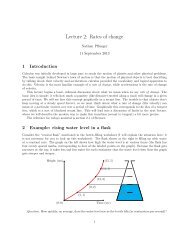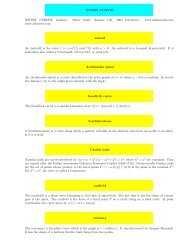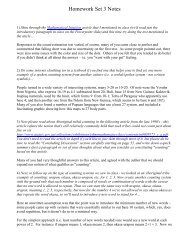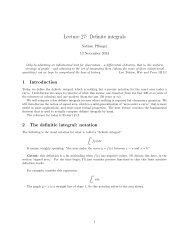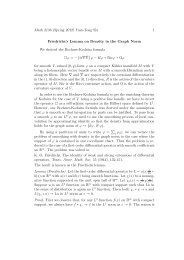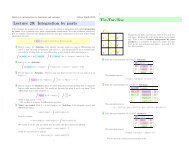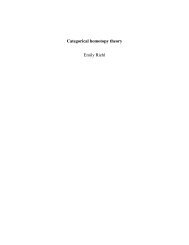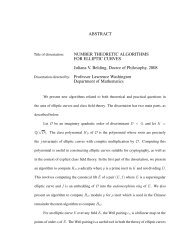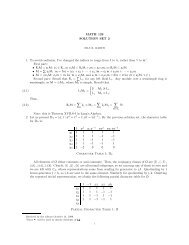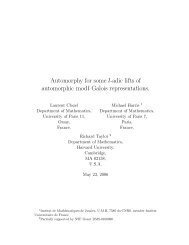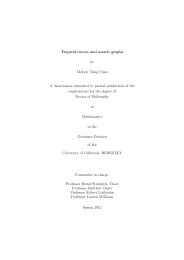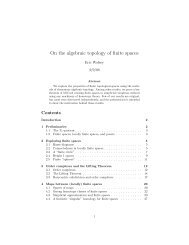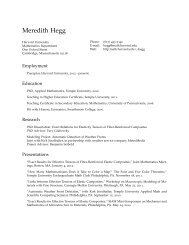Gauge theory for embedded surfaces, II
Gauge theory for embedded surfaces, II
Gauge theory for embedded surfaces, II
You also want an ePaper? Increase the reach of your titles
YUMPU automatically turns print PDFs into web optimized ePapers that Google loves.
30 P. B. Kronheimer and T. S. Mrowka<br />
is transverse to rl and that its image is disjoint from the image of the lower rl ′,<br />
<strong>for</strong> l ′ 0, we can glue X o to (W o ,Σ)<br />
to obtain a diffeomorphic copy of (X,Σ). The resulting metric gR on (X,Σ) has<br />
a cylindrical neck of length R, and has cone-angle 2π/ν along Σ. Wedenoteby<br />
K(X,Σ) the cut-down moduli space by which we hope to calculate the invariant<br />
on the left hand side in (5.1):<br />
K(X,Σ)=M α k,l ∩ V1 ∩ ...∩Vd.<br />
Here the metric gR is used, and the Vi are defined using the same sections as<br />
be<strong>for</strong>e.<br />
Proposition 5.3. For all sufficiently large R, the cut-down moduli space<br />
K(X,Σ) is diffeomorphic, by an orientation-preserving diffeomorphism, to the<br />
fibre product<br />
K(X o ) ×r M α 0,l(W o )={(A, B) | rX(A)=rl(B)}. (5.4)<br />
Proposition 5.1 follows from this straight away, because our transversality con-<br />
ditions mean that the fibre product is a zero-manifold whose points, counted<br />
with signs, add up to the product p0,l × qo k appearing in the proposition. ⊓⊔<br />
Proofof(5.3).For each pair (A, B) in the fibre product, we can find neighbourhoods<br />
U1, U2 in Mk(X o ; R s + )andMα 0,l (W o ) respectively so that A is the<br />
only connection of K(X o ) lying in U1 and such that the fibre product U1 ×r U2<br />
meets (5.4) alone. The simple gluing map (3.18) then gives an injective map<br />
˜ΦR : U1 ×r U2 −→ B α k,l (X,Σ).<br />
If V denotes the intersection V1 ∩ ...∩Vd in B α (X,Σ), then the image of ˜ ΦR<br />
meets V transversely in the unique point ˜ ΦR(A, B).<br />
By Proposition 3.19, in the version appropriate to the twisted connections,<br />
the map ˜ ΦR can be de<strong>for</strong>med, <strong>for</strong> all sufficiently large R, toamap<br />
ΦR:U1×U2−→ M α k,l (X,Σ).<br />
Furthermore, ΦR is C1-close to ˜ ΦR inside Ba k,l by (3.23), so it follows that, <strong>for</strong><br />
large R, the image of ΦR meets V transversely in one point, just as ˜ ΦR does.<br />
In this way, to each point (A, B) in the fibre product (5.4), we obtain a unique<br />
point of K(X,Σ)=Mα k,l ∩ V , so defining a map<br />
ΨR : K(X o ) ×r M α 0,l (W o ) −→ K (X,Σ).<br />
(Note that construction of this map is complicated by the fact that cutting down<br />
by V does not ‘commute’ with the gluing map ΦR, though it does commute with<br />
the approximation ˜ ΦR; see the remarks following (3.23).)



